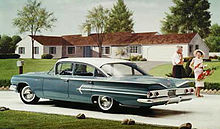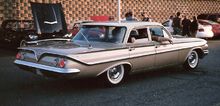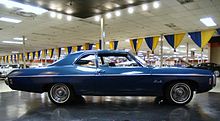- Chevrolet Bel Air
-
- See also 57 Chevy
Chevrolet Bel Air 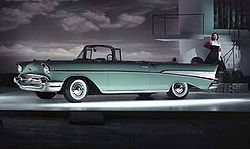
1957 Chevrolet Bel Air ConvertibleManufacturer Chevrolet Division
of General MotorsProduction 1949-1975 Model years 1950-1975 Class Full-size Layout FR layout The Chevrolet Bel Air is a full-size automobile that was produced by the Chevrolet division of General Motors for the 1950–1975 model years. Hardtops in the Chevrolet Deluxe Styleline model range were designated with the Bel Air name from 1950–1952, but it was not a distinct series of its own until the 1953 model year. Bel Air production continued in Canada for its home market only through the 1981 model year.
Contents
History
First generation (1950–1954)
First generation 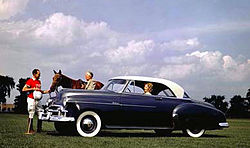
1950 Chevrolet Deluxe Styleline Bel Air HardtopProduction 1949-1954 Model years 1950-1954 Body style 2-door hardtop coupé
2-door coupé (1953-54)
4-door Sedan (1953-54)
2-door convertible
(1953-54)
4-door Station wagon (1953-54)Engine 215.5 cu in (3.5 L) "Thriftmaster" 1-bbl. valve-in-head 92hp I6[1]
235.5 cu in (3.9 L) Blue Flame I6Transmission 3-speed manual
2-speed Powerglide auto.Wheelbase 115"[1] Length 197.5"(1950-1952);[2][1] 196.5"(1954)[1] Curb weight 3,345[3] In 1950, Chevrolet came up with a revolutionary style that would set a pattern for decades. The Bel Air Hardtop(on the DeLuxe line[1][4]) was styled as a convertible with a non-detachable solid roof. Models like this had been around since the 1920s, including early Chevrolets, with no degree of success. But the newly revised idea, sweeping the GM line from Chevrolet to Cadillac, had finally found its era. First year production reached only 76,662 as buyers cautiously tested the revised concept. The car cost $1,741 and weighed 3,225 lb (1,463 kg).[5] Front suspension was independent, named "knee-action".[2]
In 1953 Chevrolet renamed its series and the Bel Air name was applied to the premium model range. Two lower series, the 150 and 210, also emerged. The 1953 Chevrolet was advertised as "Entirely new through and through," due to the restyled body panels, front and rear ends. However, essentially these Chevrolets had the same frame and mechanicals as the 1949-52 cars. The Bel Air series featured a wide chrome strip of molding from the rear fender bulge, to the rear bumper. The inside of this stripe was painted a coordinating color with the outside body color, and "Bel Air" scripts were added inside the strip. Lesser models had no model designation anywhere on the car, only having a Chevy crest on the hood and trunk. 1953 was the first year for a curved, one-piece windshield.[6][1] Bel Air interiors had a massive expanse of chrome across the lower part of the dashboard, along with a de luxe Bel Air steering wheel with full chrome horn ring. Carpeting and full wheel covers rounded out Bel Air standard equipment. For 1954, the Bel Air stayed essentially the same, except for a revised grille and taillights. During these years, there were two engine choices, depending on the transmission ordered. Both engines were "Blue Flame" inline six cylinder OHV engines, featuring hydraulic valve lifters and aluminum pistons. The 115 hp (86 kW) engine was standard on stickshift models, with solid lifters and splash plus pressure lubrication. Powerglide cars got a 125 hp (93 kW) version which had hydraulic lifters and full pressure lubrication. In 1953-54, Bel Airs could be ordered in convertible, hardtop coupe, 2- and 4-door sedans, and, for 1954, the Beauville station wagon which featured woodgrain trim around the side windows. Power steering was optional for 1953; 1954 added power brakes, power seat positioner and power front windows. 1954 cars with stick shift used the 1953 Powerglide engine.
Second generation 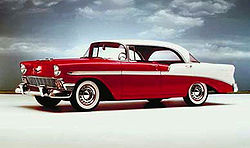
1956 Chevrolet Bel Air Hardtop Sport SedanProduction 1954–1957 Model years 1955-1957 Assembly Caracas, Venezuela[7]
Oshawa, Ontario, Canada
Arlington, TexasBody style 2-door hardtop
4-door hardtop (1956-57)
4-door sedan
2-door convertible
2-door Station wagon
4-door Station wagonEngine 215.5 cu in (3.5 L) I6
235.5 cu in (3.9 L) Blue Flame I6
265 cu in (4.3 L) V8
283 cu in (4.6 L) V8 (1957)Transmission 3-speed manual[8]
2-speed Powerglide auto.
3-speed Turboglide auto.Wheelbase 115"[9] Length 195.6" Related Chevrolet 210
Chevrolet 150
Chevrolet NomadSecond generation (1955–1957)
For 1955, Chevrolet's full-size model received new styling that earned it the "Hot One" designation by enthusiasts. Unlike Ford and Plymouth, Chevrolet's styling was considered crisp and clean. Bel Airs came with features found on cars in the lower models ranges plus interior carpet, chrome headliner bands on hardtops, chrome spears on front fenders, stainless steel window moldings,[1] and full wheel covers. Models were further distinguished by the Bel Air name script in gold lettering.[9] For 1955 Chevrolets gained a V8 engine option. The new 265 cu in (4,340 cc) V8 featured a modern, overhead valve high compression, long stroke design that was so good that it remained in production in various forms, for many decades. The base V8 had a two-barrel carburetor and was rated at 162 hp (121 kW), and the "Power Pack" option featured a four-barrel carburetor and other upgrades yielding 180 bhp (130 kW). Later in the year, a "Super Power Pack" option added high-compression and a further 15 bhp (11 kW). "Idiot" lights replaced gauges for the generator and oil pressure.[10] Motor Trend magazine gave the Bel Air top marks for handling.[10] Front legroom was 43.1".[1]
The 1956 Bel Air received a face-lift with a more conventional full-width grille, pleasing those customers who didn't favor the Ferrari-inspired '55 front end. Distinctive two-tone bodyside treatments and graceful front and rear wheel openings completed the "speedline" restyling. Single housings incorporated the taillight, stoplight, and backup light, and the left one held the gas filler - an idea popularized on Cadillacs. Among the seven Bel Air models was a new Sport Sedan, a pillarless four-door hardtop that looked handsome with all the windows rolled down and allowed easy entry into the back seat. Production exceeded 103,000, compared to 128,000 two-door hardtops. Shapely two-door Nomad wagons topped the price chart at $2,608, but now carried the same interior and rear-wheel sheetmetal as other Bel Airs, lacking the original's unique trim. Only 7,886 were built. The least costly Bel Air, at $2,025, was the two-door sedan. Seatbelts, shoulder harnesses, and a padded dashboard were available,[10] and full-size cars could even get the hot Corvette 225-horsepower engine.
In 1957 engine displacement grew to 283 cu in (4,640 cc) with the "Super Turbo Fire V8" option producing 283 hp (211 kW) with the help of continuous (closed loop) mechanical fuel injection. These so-called "fuelie" cars are quite rare, since most Bel Airs were fitted with carburetion. The 1957 Bel Air is among the most recognizable American cars of all time; well-maintained examples, especially Sport Coupes and Convertibles are highly sought after by collectors and enthusiasts. They are roomy, fuel-efficient, with tastefully restrained, period use tail fins and chrome. A second automatic transmission, Turboglide, was optional. While the original two-speed Powerglide continued unchanged, Turboglide provided a continuously-variable gear ratio which made "shifting" imperceptable. The shift quadrant on Turboglide cars followed a "P R N D Lr" pattern.
From 1955–57, production of the two-door Nomad station wagon was assigned to the Bel Air series, although its body and trim were unique to that model. Prior to becoming a regular production model, the Nomad first appeared as a Corvette-based concept vehicle in 1954. Chevrolet has since unveiled two concept cars bearing the Nomad name, most recently in 1999. The 1955-1957 Chevrolets are commonly referred to as TriFives.
The '55-'57s were made in right-hand drive and shipped from Oshawa, Canada, for local assembly in Australia (CKD), New Zealand (SKD) and South Africa. All three model years had a reversed version of the '55 LHD dashboard and did not get the LHD models' 1957 redesign.
Third generation (1958)
Third generation 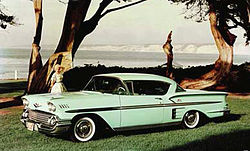
1958 Chevrolet Bel Air Impala Hardtop Sport CoupeProduction 1957-1958 Model years 1958 Assembly Arlington, Texas, United States
Oshawa, Ontario, CanadaBody style 2-door coupe
2-door hardtop
4-door sedan
4-door hardtop
2-door convertibleEngine 235.5 cu in (3.9 L) 145hp Blue Flame I6
283 cu in (4.6 L) V8
348 cu in (5.7 L) 250-315hp V8[1]Transmission 3-speed manual
2-speed Powerglide auto.Wheelbase 117.5" Length 209.1"[1] Height 57.1"[13] Related Chevrolet Biscayne
Chevrolet DelrayFor 1958, Chevrolet models were redesigned longer, lower, and heavier than their 1957 predecessors, and the first ever production Chevrolet big block V8, the 348 cu in (5,700 cc), was now an option. The Bel Air gained a halo vehicle in 1958, the Impala, available only as a hardtop coupe and convertible in its introductory year. Impala styling followed the basic lines of the other Chevrolet models but received special styling cues including a different roof line, a vent above the rear window, unique side trim, and triple tail lights housed in slightly broader alcoves. For the budget conscious, the Biscayne, (formerly the 210) and the Delray (formerly the 150) completed this model year's family-oriented and utility offerings.
Chevrolet's design for the year fared better than its other GM offerings, and lacked the overabundance of chrome found on Pontiacs, Oldsmobiles, Buicks and Cadillacs. Complementing Chevrolet's front design was a broad grille and quad headlights that helped simulate a 'Baby Cadillac'; the tail received a fan-shaped alcove on both side panels, which housed dual tail lights. Despite being a recession year, consumers made Chevrolet the No. 1 make of automobile (beating Ford, which held the title in 1957) and the Bel Air was at the core of Chevrolet's popularity. With its wide variety of body styles and models, Bel Airs could be optioned with almost every conceivable luxury within the Chevrolet line. The Nomad station wagon name also reappeared in 1958 when the vehicle bowed as the premium four-door Chevrolet station wagon, lacking the unique styling of the 1955-57 Nomads. Most Chevrolet station wagon models had two tail lights housed in abbreviated alcoves, which were made smaller to accommodate the rear gate. A new dash was used.[14]
Fourth generation (1959–1960)
Fourth generation 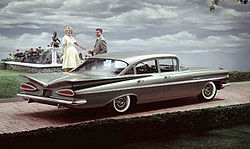
1959 Chevrolet Bel Air SedanProduction 1958-1960 Model years 1959-1960 Assembly Arlington, Texas, United States
Oshawa, Ontario, CanadaBody style 2-door coupe
2-door hardtop (1960)
4-door sedan
4-door hardtopEngine 235.5 cu in (3.9 L) Blue Flame I6
283 cu in (4.6 L) V8
348 cu in (5.7 L) V8Transmission 3-speed manual[1]
4-speed manual
2-speed Powerglide auto.Wheelbase 119"[1] Length 210.9"[1] Related Chevrolet Biscayne
Chevrolet ImpalaFor the second time in as many years, Chevrolet again came up with a totally new car. From the front or rear the 1959 Chevrolets resembled nothing else on the road. From the headlights placed as low as the law would allow to the cats-eye tail lights, the 1959 Chevrolet was a brand new car with all new sheet metal, a new frame, and even new series names. The most visual new change was the flat, wing shaped tailfins.[1] The car was built on a 119 in (3,000 mm) wheelbase and was 211 inches (5,400 mm) long-which was 11 in (280 mm) longer than the 1957 model. This made Chevrolet the longest car in the low-priced range, whereas two years before it had been the shortest. In addition, the car was 3 in (76 mm) wider outside and had 5 in (130 mm) more width inside than it did in 1958, through the reduction of door thickness. The frame was new, called GM X frame, and it had no side rails.[15] The Bel Air, which had been the top line series since 1953, was now the middle range. Wagons were still classed by themselves, but had model numbers matching the car series. Parkwood 6-passenger and Kingswood 9-passenger wagons had Bel Air's model number, and as such were the middle range wagons. Under the hood, little change took place. A variety of speed options, such as fuel injection, special cams and lowered compression, gave horsepower ratings up to 315. Bel Air production was 447,100. The new Impala line surpassed Bel Air production by 20,000 units.
Little change was made for 1960. The new models were refinements in the 1959 style with a much more restrained front end, double tail lights compared to the startling cat's eyes of 1959. Under the hood, things remained constant. Fuel injection was no longer available, but with the 348 cubic inch engine, a horsepower rating of 335 at 5800 rpm was now achieved. This involved the use of three 2-barrel carburettors, a special cam and an 11.25:1 compression ratio, all sold as a package. New to the Bel Air series was the Sport Coupe, which used the Impala's 2-door hardtop body, but lacked the Impala's trim. The Bel Air Sport Sedan continued to use a rear window overhang and a huge wraparound rear window. Bel Airs (and Biscaynes) had two tail lights per side; the Impalas had three tail lights per side—a situation that would persist for most years through 1975. Many of the same options and accessories that were available on the Impala were also available on the Bel Air. The Bel Airs had more interior and exterior brightwork than the Biscayne.
Fifth generation (1961–1964)
Fifth generation 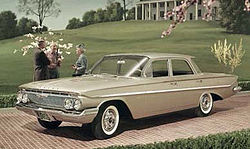
1961 Chevrolet Bel Air SedanProduction 1960-1964 Model years 1961-1964 Assembly Arlington, Texas, United States
Oshawa, Ontario, CanadaBody style 2-door coupe
2-door Hardtop (61-62)
4-door sedan
4-door wagon (62-64)
4-door Hardtop (61)Engine 235.5 cu in (3.9 L) I6
230 cu in (3.8 L) I6 (63-64)
283 cu in (4.6 L) V8
348 cu in (5.7 L) V8 (61)
327 cu in (5.4 L) V8 (62-64)
409 cu in (6.7 L) V8Transmission 3-speed manual
4-speed manual
3-speed Powerglide auto.Related Chevrolet Biscayne
Chevrolet ImpalaFor 1961, Chevrolet again had a totally new body, not just new sheetmetal. Its wheelbase remained 119 in (3,000 mm), but its length was now reduced slightly to 209.3 in (5,320 mm). All engines options of the previous year remained in effect with the standard engines being the 235.5 CID Six of 135 hp (101 kW) or the 283 CID V8 of 170 hp (130 kW). The V8 cost $110 more than the Six and weighed 5 lb (2.3 kg) less.
The Bel Air 2-door sedan used squared-off roof styling and large wrap-around rear window as opposed to the hardtop's swept-back design. The Bel Air 4-door Sport Hardtop still used a different roof line than did the 4-door sedan.
For 1962, all sheetmetal except the door panels was changed. Overall length was stretched slightly to 209.6 in (5,320 mm). The 4-door Sport Hardtop was no longer offered in the Bel Air series. Standard engines remained the same as the previous year. A new 327 cu in (5,360 cc) V8 of 250 or 300 hp (220 kW) was offered in addition to the giant (for the time) 409 cu in (6,700 cc) V8 of 380 hp (280 kW) or 409 hp (305 kW) with the dual four-barrel carburetor setup. All wagons this year were 4-door models and separate distinctions for wagons were dropped. Now all models were either Biscayne, Bel Air or Impala series. Full carpeting returned as standard equipment on all 1962 Bel Air models for the first time in several years.
For 1963, the full size Chevrolet received little more than a facelift. Overall length increased to 210.4 in (5,340 mm). Replacing the older 235 cubic-inch six-cylinder engine as standard equipment was a new 230 cubic-inch six-cylinder of more modern design with a 140-horsepower rating that was based on the 194 cubic-inch six introduced on the compact Chevy II Nova the previous year. The base V8 remained the 283 CID, which was upgraded to produce 195 hp (145 kW). The 409 CID V8 was now offered in 340, 400 and 425 hp (317 kW) versions, while the small block 327 V8 continued with options of 250 and 300 horsepower. The Bel Air continued to be Chevrolet's middle range, but it now consisted of only two car models- the 2-door sedan and the 4-door sedan. 6 and 9-passenger Bel Air station wagons were again offered.
For 1964, very few changes were made except the expected sheet metal and trim renovations. Cars were 209.9 in (5,330 mm) in length while the wagons were 210.8 in (5,350 mm) long. In addition to the un-changed standard engines, there were two different 327 CID engines were offered, developing from 250 hp (190 kW) to 300 hp (220 kW) and three 409 CID engines ranging from 340 hp (250 kW) to 425 hp (317 kW). Except for a chrome belt line and $100 difference in price there was little exterior difference between the Bel Air and Biscayne version.
Sixth generation (1965–1970)
Sixth generation 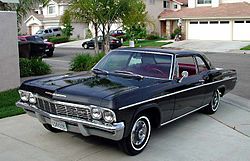
1965 Chevrolet Bel Air 2-door SedanProduction 1964-1970 Model years 1965-1970 Assembly Arlington, Texas, Doraville, United States
Oshawa, Ontario, CanadaBody style 2-door coupe (65-69)
4-door sedan
4-door wagon (65-69)Engine 230 cu in (3.8 L) I6 (65-66)
250 cu in (4.1 L) I6 (65-70)
283 cu in (4.6 L) V8 (65-67)
327 cu in (5.4 L) V8 (65-67)
307 cu in (5.0 L) V8 (68)
350 cu in (5.7 L) V8 (69-70)
400 cu in (6.6 L) V8 (69-70)
409 cu in (6.7 L) V8 (65-66)
396 cu in (6.5 L) V8 (65-70)
427 cu in (7.0 L) V8 (67-70)Transmission 3-speed manual
4-speed manual
3-speed Powerglide auto.
3-speed Turbo Hydramatic auto.Related Chevrolet Biscayne
Chevrolet Impala
Chevrolet CapriceFor 1965, the full size Chevrolet was totally restyled, and the cars were stretched to 213.3 in (5,420 mm) overall, even though the wheelbase remained the same. The new stamped grill had a lower extension below the bumper which was slightly Veed. Curved window glass and round taillights mounted high characterized the new styling. The interiors were also redesigned and a very attractive dash resulted. The standard V8 remained the 283 CID model of 195 hp (145 kW), but options included two new 396 cu in (6,490 cc) CID engines of 325 and 340 hp (250 kW) and two 409 CID blocks of 400 and 425 hp (317 kW).
The Bel Air utilizes a stainless-steel belt and rocker molding, identifying signature on the rear fenders, a glove compartment light and power tailgate on 9-passenger wagons to distinguish itself from the lower-priced Biscayne series.
For 1966, Chevrolet was in its second season of a totally new body change, so mild facelifting sufficed including forward thrusting, blunted front fenders and a revised grill. At the rear, a break with the traditional round taillamps took place. Bel Air and Biscayne featured dual rectangular lamps with back-up lamps built in. Overall length was 213.2 in (5,420 mm). The standard Six cylinder engine this year was the larger 250 CID version of 155 hp (116 kW). New for the speed set was a 427 cu in (7,000 cc) V8 of 390 or 425 hp (317 kW). Bel Air was readily distinguishable from Biscayne by its full length body side molding and rear fender Bel Air signatures. All-vinyl interiors were now standard on station wagons while cloth and vinyl trims continued on sedans.
For 1967, Full-sized Chevrolets featured a new body with bulging rear fenders, one of this year's styling trends, not necessarily appreciated by everyone. Bel Air 2 and 4-door Sedans continued in addition to 6 and 9-paasenger wagons. This year Bel Air featured triple taillights unlike Biscayne's dual units. Standard engines remained the same as the previous year. Optional engines were a 327 CID V8 of 275 hp (205 kW), the 396 CID V8 of 350 hp (260 kW); or the 427 CID V8 of 385 hp (287 kW), plus various speed packages.
For 1968, the Full-sized Chevrolets received some changes but were quite similar to the 1967 models, though they had grown one inch to 214.7 in (5,450 mm). Chevrolet's new grill design bears a strong resemblance to Cadillac's, but Bel Air's dual round taillight design is strictly Chevrolet. In an unusual move, the taillights were mounted in the bumper. In addition to the 250 CID Six of 155 hp (116 kW), standard engines included the new 307 cu in (5,030 cc) V8 of 200 hp (150 kW). The Bel Air with the standard 250 Six was capable of a top speed of 90 mph (140 km/h) and 18.4 mpg-US (12.8 L/100 km; 22.1 mpg-imp) at cruising speeds. When powered by the new 307 CID V8, the Bel Air series cars had a top speed of 105 mph (169 km/h) and 17.1 mpg-US (13.8 L/100 km; 20.5 mpg-imp) at cruising speeds.
For 1969, the big Chevrolet was totally redesigned, given a new length, new fender and body lines, and a new front and back end, but continued using the basic 1965 chassis, innerbody structure and even the rooflines of pillared two- and four-door sedans. The cars also remained on the 119 in (3,000 mm) wheelbase, but grew to a new length of 219.9 in (5,590 mm), while the wagons grew 4.3 in (110 mm) to a new length of 217.7 Engine offerings included a standard 250 cubic-inch six-cylinder and 235-horsepower 327 V-8, and optional V-8 engines included two 350s of 255 and 300 horsepower, a 396 rated at 265 horsepower and three 427 V8s 335 hp (250 kW), 390 hp (290 kW), and 425 hp (317 kW). This was the final year for the Bel Air 2-door sedan and the Bel Air based station wagon was renamed Townsman, as part of a Chevrolet move to revert back to the pre-1962 practice of using different nameplates on station wagons than other models. Three- and four-speed manual transmissions were again offered along with the two-speed Powerglide automatic with the six-cylinder, and 327 and 350 V-8s; and the three-speed Turbo Hydramatic, offered only with the big-block V-8s since its 1965 introduction, was now available with all engines.
For 1970, the Chevrolet line was very little changed and regulated primarily to a new and very attractive front end. The standard Six was still the 250 of 155 HP. The standard V8 in full-size Chevrolets was now the 350 cu in (5,700 cc)of 250 hp (190 kW). Optional V-8 engines included a 300-horsepower 350 and 265-horsepower 400, with the top offering a 454 cu in (7,440 cc) of 345 hp (257 kW). The Bel Air series was now a one model 4-door sedan while the station wagon was again sold under the Townsman nameplate.
Seventh generation (1971–1975)
Seventh generation 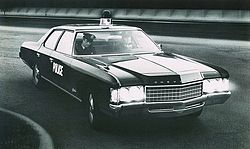
1971 Chevrolet Bel Air Police SedanProduction 1970-1975 Model years 1971-1975 Assembly Arlington, Texas, United States
Oshawa, Ontario, CanadaBody style 4-door sedan
2-door coupe
4-door wagonPlatform B-body Engine 350 cu in (5.7 L) V8
400 cu in (6.6 L) V8
454 cu in (7.4 L) V8
250 cu in (4.1 L) I6Transmission 3-speed manual (standard, 1971-'73 on six-cylinder cars)
3-speed Turbo-Hydramatic auto. (optional 1971-'73 on six-cylinder cars; standard on V-8 powered cars from mid-1971 on)Related Chevrolet Biscayne
Chevrolet Impala
Chevrolet CapriceBy the late 1960s (with the introduction of the Caprice), the Bel Air and its Biscayne stablemate were primarily marketed to automotive fleet customers. However, the Bel Air remained available to retail customers who sought a basic, no-frills, full-sized car that was better trimmed than the low-line Biscayne. When the Biscayne was discontinued after 1972, the Bel Air was demoted to the low-level model. Bel Airs again used four-segmented taillights as opposed to the triple-segmented lights of higher-level Impala and Caprice models, except in 1972 when all models shared the same triple-segmented lights mounted in the bumper.
A 250-cubic-inch six-cylinder engine and three-speed manual transmission with column shift remained standard equipment through the 1973 model year on sedans with the 350 V8 and automatic standard on wagons—the Turbo Hydramatic automatic had been the sole transmission choice on V-8-powered Bel Airs since the spring of 1971 though the old two-speed Powerglide was still offered with the six-cylinder engine through the 1972 model year. Only about 1,400 cars were built with the inline six in 1973. The engine and manual transmission were shelved by the end of the model year—marking the last full-sized, "body on frame" American car to offer a manual gearbox.
All Bel Air sedans built in 1974–1975 listed a 350 two-barrel V8 engine and Turbo-Hydramatic transmission as standard, with station wagons getting the 400 cu in (6,600 cc) four-barrel V8, again with Turbo-Hydramatic standard. The 400 V8 was optional on sedans and the 454 was available on both models.
With the discontinuation of the Bel Air two-door sedan after the 1969 model year, all U.S.-market Bel Airs sold between 1970 and 1975 were four-door sedans or station wagons—the latter carrying the Townsman nameplate from 1969–1972 and Bel Air from 1973-1975. However, a Bel Air hardtop coupe—based on the Impala Sport Coupe body—was sold in Canada from 1970-1975. This body even had a roofline similar to the original '66-67 Caprice coupe style for 1974-1975.
Most other changes to the Bel Air during its final years were identical to the more expensive Caprice and Impala lines, some of which were mandated by government safety regulations in the U.S. that included 5 mph (8.0 km/h) front bumpers in 1973 and similar-designed rear bumpers in 1974. The 1975 models had a new roofline and (along with the Impala) grille that was a direct copy of the 1974 Caprice front end. Inside, there were new instrument cluster markings, radio and climate control graphics (the speedometer read up to 100 mph (160 km/h), and had smaller numbers for kilometers per hour). Customers could buy their 1975 Bel Air with two new options: an Econominder gauge package (which included a gauge that monitored fuel economy, due in part to growing demands for fuel economy as well as a temperature gauge) and intermittent wipers.
In 1975, Consumer Reports tested a Bel Air four-door sedan with the 350 V8 engine and Turbo Hydramatic against other U.S.-built full-sized cars of that period including the Pontiac Catalina, Ford LTD and Plymouth Gran Fury. Although the car performed well in its tests and placed second to the Pontiac, Consumer Reports pointed out the Bel-Air had less noise insulation and a less-comfortable rear seat than its higher-priced siblings, and that a comparably equipped Chevrolet Impala (with additional sound insulation, and upgraded upholstery and seat padding, a $203 premium over the Bel-Air) "would be even closer to the Pontiac in overall quality." Even so, the magazine stated that—for instance—the Bel-Air was "only slightly noisier than the Pontiac". Consumer Reports concluded in its report that prospective buyers should pay the extra $200 or so to upgrade to the costlier Impala, noting advantages such as greater resale value and interior-exterior appointments more comparable to the other tested full-sized vehicles.[16]
The last Bel Airs for the U.S. were manufactured for 1975. For 1976, a lower-trimmed Impala "S" four-door sedan was a one-year offering which had less standard equipment than regular Impalas and functioned as a replacement for the Bel Air.
Canada only Bel Airs
Eighth generation (1976-1981)
Eighth generation Production 1976–1981 Model years 1977–1981 Assembly Oshawa, Ontario, Canada Body style 2-door coupe
4-door sedan
4-door station wagonPlatform B-body Engine 250 cu in (4.1 L) I6
305 cu in (5.0 L) V8
400 cu in (6.6 L) V8Transmission 3-speed Turbo-Hydramatic auto. Wheelbase 116 in (2,900 mm) Related Chevrolet Impala
Chevrolet Caprice
Pontiac Laurentian
Pontiac ParisienneIn Canada, Chevrolet continued the Bel Air as its lowest-priced full-size car through the 1981 model year. For 1977, Canadian Bel Airs received the same downsizing as their Impala/Caprice counterparts in the U.S. Body styles offered during this period were a four-door sedan, two-door coupe and station wagon. Reflecting the smaller size of these downsized big cars was a lineup of generally smaller engines for improved fuel economy with Chevy's 250 cubic-inch six-cylinder reinstated as standard power in sedans for the first time since 1973, with the 140 hp (100 kW) 305 V8 available as an option in sedans and standard on wagons. The 170 hp (130 kW) 350 V8, available in both models, was now the top option as the larger 400 small block and 454 big block V8s were no longer available. Standard equipment on Bel Airs during this period included small hubcaps, cloth-and-vinyl upholstery in sedans or all-vinyl in wagons, cigarette lighter, ashtray, automatic dome light for front doors, full carpeting, Astro Ventilation, Delco Freedom battery, variable-ratio power steering, power front disc brakes and Turbo Hydramatic automatic transmission.
The 1980 Bel Air along with other full-size Chevrolets, was revised with all-new exterior sheet metal, which helped improve aerodynamics and thus fuel economy; the car was also fitted with a new grille, identical to that of the higher-priced Impala. Also that year, the engine lineup was revised with the inline six replaced by a new 3.8-liter or 229 cubic-inch V6 based on the small-block V8 as the base engine in sedans. The new base V8 (standard on wagons, optional on sedans) was a smaller 267 cubic-inch small-block with two-barrel carburetor, while the 305 small-block (optional on all models) got a 15 hp (11 kW) increase to 155 hp (116 kW) thanks to the change from a two-barrel to four-barrel carburetor. The 350 V8 was now restricted to police-option vehicles. Another new option for 1980-81 was the Oldsmobile-built 350 Diesel.
With a dramatic downturn in full-size car sales, the Bel Air was dropped after the 1981 model year, as were a number of other low-trim full size cars in the Canadian market including the Pontiac Laurentian, Mercury Marquis Meteor, and the Ford Custom 500.
2002 Bel Air Concept
2002 Bel Air Concept 
2002 Chevrolet Bel Air ConceptBody style 2-door convertible Engine 211 cu in (3.5 L) 20 valve DOHC I5 L52 Vortec 3500 concept engine Transmission 4-speed Turbo-Hydramatic 4l60-E electronically controlled automatic Wheelbase 111"[17] Length 191" In 2002, a concept Bel Air convertible was shown at the North American International Auto Show. It features a few styling and design cues from the legendary 1955–57 models, such as the chrome windshield frame, traffic light viewfinder, and a gas filler cap behind the tail light, similar to 1956-1957 Chevy's gas cap behind the chrome trim on the back of the tail fin, but more like the 1948-1958 Cadillac gas cap light. It also features the same a body on frame hydroforming technology (used in the frame rails of the Corvette and GM’s midsize sport-utility vehicles) and a sheet metal body, on a 111 in (2,800 mm) wheelbase, and a 65 in (1,700 mm) track. Suspension is short long arm up front and Hotchkiss drive in the rear. It rides on five-spoke aluminum wheels with 18 in (46 cm) red line tires and anti lock discs all-round. The elegant, yet simple interior features a twin-element instrument panel, column-mounted gearshift and bench seats covered in soft high-tech fabrics colored red to match the exterior that are cleverly designed to slide forward for easier backseat entry. It also served as a showcase for the their new turbocharged inline five-cylinder concept engine based on the L52 (Vortec 3500), straight-5 truck engine. According to a September 2002 GM press release, the all-aluminum 3.5 L (211 cu in) 20 valve DOHC engine, with a bore of 93.0 mm (3.7 in), and a stroke of 102.0 mm (4 in), that delivers up to 315 horsepower and 315 lb·ft (427 N·m) of torque, mated to a Hydra-Matic 4L60-E electronically controlled four-speed automatic. A virtual "turbo boost" button on the steering wheel activates the powertrain control module to trigger a more aggressive spark and fueling calibration for maximum horsepower. It also led the 13th Annual Stater Brothers Route 66 Rendezvous as the official vehicle in September 2002. General Motors has shown no interest in producing the car.[18]
Drag Racing
Of noteworthy importance is the 1962 Bel Air Sport Coupe, the last year a Bel Air hardtop was available. This model featured the "bubbletop" roof from 1961, and was popular with drag racers who ordered the car with the new-for-'61 409 cubic inch "W-block" V8 with up to 409 bhp (305 kW); a special package including aluminum body panels, heater delete, and four-speed manual transmission. A car with this configuration is a valuable collector vehicle that commands a big premium over other 1962 models including the Super Sport.
Gallery - Chevrolet Bel Air
1954 Bel Air Hardtop1955 Bel Air Coupe1957 Bel Air Sedan1958 Bel Air 2-Door Sedan1960 Bel Air 4-Door SedanSee also
References
- ^ a b c d e f g h i j k l m n Flory, Jr., J. "Kelly" (2008). American Cars, 1946-1959 Every Model Every Year. McFarland & Company, Inc., Publishers. ISBN 978-0-7864-3229-5.
- ^ a b "Directory Index: Chevrolet/1951_Chevrolet/1951_Chevrolet_Foldout". Oldcarbrochures.com. http://www.oldcarbrochures.com/static/NA/Chevrolet/1951_Chevrolet/1951_Chevrolet_Foldout/1951%20Chevrolet%20Foldout-01.html. Retrieved 2011-11-20.
- ^ "Directory Index: Chevrolet/1952_Chevrolet/1952_Chevrolet_Specs". Oldcarbrochures.com. http://www.oldcarbrochures.com/static/NA/Chevrolet/1952_Chevrolet/1952_Chevrolet_Specs/1952%20Chevrolet%20Specs-10.html. Retrieved 2011-11-20.
- ^ "Directory Index: Chevrolet/1952_Chevrolet/1952_Chevrolet_Specs". Oldcarbrochures.com. http://www.oldcarbrochures.com/static/NA/Chevrolet/1952_Chevrolet/1952_Chevrolet_Specs/1952%20Chevrolet%20Specs-08.html. Retrieved 2011-11-20.
- ^ Sixty years of Chevrolet by George H. Dammann
- ^ "Directory Index: Chevrolet/1953_Chevrolet/1953_Chevrolet_Brochure". Oldcarbrochures.com. http://www.oldcarbrochures.com/static/NA/Chevrolet/1953_Chevrolet/1953_Chevrolet_Brochure/1953%20Chevrolet-03.html. Retrieved 2011-11-20.
- ^ "Gm En Venezuela Y El Mundo - Historia". Gm.com.ve. http://www.gm.com.ve/content_data/LAAM/VE/es/GBPVE/microsite/gm/historia.html. Retrieved 2010-09-30.
- ^ "1956 Chevrolet (U.S.) Bel Air 2-Door Sedan performance data, specs & photo". Automobile-catalog.com. http://www.automobile-catalog.com/make/chevrolet_usa/full-size_chevrolet_4gen/full-size_bel_air_2gen_2-door_sedan/1956.html. Retrieved 2011-11-20.
- ^ a b Gunnell, John A., ed. Standard Catalog of American Cars 1946-1975. krause publications. ISBN 0-87341-027-0.
- ^ a b c Consumer Guide Chevrolet 1955-1957. Publications International. 1991. ISBN 0-70989-37611-3.
- ^ "Directory Index: Chevrolet/1956_Chevrolet/1956_Chevrolet_Owners_Manual". Oldcarbrochures.com. http://www.oldcarbrochures.com/static/NA/Chevrolet/1956_Chevrolet/1956_Chevrolet_Owners_Manual/1956%20Chevrolet%20Manual-11.html. Retrieved 2011-11-20.
- ^ "Directory Index: Chevrolet/1957_Chevrolet/1957_Chevrolet_Owners_Manual". Oldcarbrochures.com. http://www.oldcarbrochures.com/static/NA/Chevrolet/1957_Chevrolet/1957_Chevrolet_Owners_Manual/1957%20Chevrolet%20Manual-13.html. Retrieved 2011-11-20.
- ^ "Directory Index: Chevrolet/1958_Chevrolet/1958_Chevrolet_Owners_Manual". Oldcarbrochures.com. http://www.oldcarbrochures.com/static/NA/Chevrolet/1958_Chevrolet/1958_Chevrolet_Owners_Manual/1958%20Chevrolet%20Guide-29.html. Retrieved 2011-11-20.
- ^ "Directory Index: Chevrolet/1958_Chevrolet/1958_Chevrolet_Owners_Manual". Oldcarbrochures.com. http://www.oldcarbrochures.com/static/NA/Chevrolet/1958_Chevrolet/1958_Chevrolet_Owners_Manual/1958%20Chevrolet%20Guide-04.html. Retrieved 2011-11-20.
- ^ "Directory Index: Chevrolet/1959_Chevrolet/1959_Chevrolet_Brochure". Oldcarbrochures.com. http://www.oldcarbrochures.com/static/NA/Chevrolet/1959_Chevrolet/1959_Chevrolet_Brochure/1959%20Chevrolet-22.html. Retrieved 2011-11-20.
- ^ "Full-Sized Sedans: Pontiac, Chevrolet, Plymouth, Ford", Consumer Reports, February 1975, pg. 103
- ^ Newbury, Stepehn (2002). The car design yearbook 1. Merrell Publishers Limited. ISBN 1-85894-190-3.
- ^ 2002 GM press release
- Gunnell, John, Editor (1987). The Standard Catalog of American Cars 1946-1975. Kraus Publications. ISBN 0-87341-096-3.
- Biel, John (2005), "A Glass Half Full: The Story of the 1958 Chevrolet", Collectible Automobile 21 (6): 8–23, http://auto.consumerguide.com/product/collectible/index.cfm
External links
Type 1950s 1960s 1970s 0 1 2 3 4 5 6 7 8 9 0 1 2 3 4 5 6 7 8 9 0 1 2 3 4 5 6 7 8 9 Subcompact Vega Monza Chevette Compact Corvair Corvair Chevy II / Nova Nova Nova Nova Mid-size Chevelle / Malibu Chevelle / Malibu Malibu Monte Carlo Monte Carlo Monte Carlo Full-size Fleetline 150 150 Delray Styleline 210 210 Biscayne / Brookwood Deluxe Bel Air Bel Air Bel Air Bel Air Bel Air Bel Air Bel Air Beauville Impala Impala Impala Impala Impala Impala Nomad Nomad Caprice Caprice Caprice Sports Camaro Camaro Corvette Corvette Corvette Categories:- Chevrolet vehicles
- Chevrolet concept vehicles
- Vehicles introduced in 1953
- Rear wheel drive vehicles
- Sedans
- Station wagons
- 1950s automobiles
- 1960s automobiles
- 1970s automobiles
- 1980s automobiles
- Motor vehicles manufactured in the United States
- Canadian automobiles
Wikimedia Foundation. 2010.




